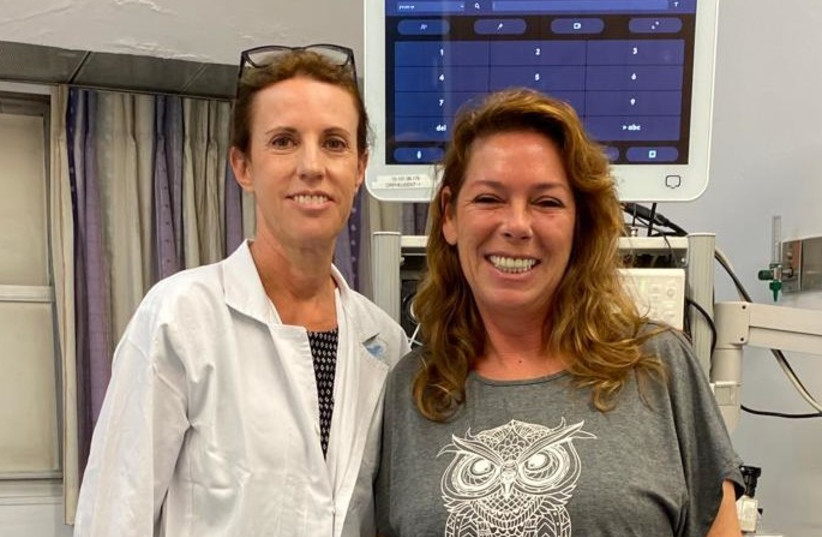Shirli Aharon, a married, 53-year-old mother of three from Eilat, can’t remember the last time she spoke regularly.
About a decade ago, she began to have difficulty speaking that got worse over time until she was unable to utter a single word. Shirley began to withdraw more and more into herself, until she stopped communicating entirely.
She was diagnosed with spasmodic dysphonia, also known as laryngeal dystonia – a neurologic disorder that can affect the voice and speech.
What is spasmodic dysphonia?
It is a lifelong condition that causes the muscles that generate a person’s voice to go into periods of spasm. In some cases, the disorder is temporary or can be improved through treatment. It most commonly begins when an adult reaches middle age, and women are affected more often than men.
A famous person who has the disease is Robert F. Kennedy Jr., the 69-year-old Democratic Party candidate for US president, who developed a raspy voice in 1996. He is the son of the murdered former US attorney-general and senator Robert F. Kennedy and a nephew of former US president John F. Kennedy.

The disease is a disorder whose exact cause is unknown, but most cases result from a trigger in the brain and nervous system that can affect the voice. Although it isn’t life threatening, it is life changing for those who have it.
The symptoms include breaks or interruptions in speech, often every few sentences; a hoarse, grating voice that can also sound strained or strangled; odd sounding speech that is difficult to understand; and gradual or sudden difficulty speaking.
The new surgical treatment developed by doctors in Japan for spasmodic dysphonia is a bilateral thyroarytenoid myectomy – excision of part of a muscle – after which fat tissue is removed from the abdomen and inserted into vocal fold to fill in the muscle and to prevent scarring.
This weakens the vocal folds bilaterally to prevent spasms.
“Losing my voice happened in a very long process, during which I went to countless doctors in order to try to diagnose the problem and each time they would check me and tell me everything was fine and send me home without a diagnosis,” recalled Aharon. “I was very ashamed; every time I spoke, I felt my heart shrink inside. I would apologize to people for... why my voice was distorted or hoarse. It was terrible.
“I couldn’t talk to people from work and market my business, which hurt me financially. I had difficulty with the simplest things. Every day I had to make appointments for doctors and tests, talk to my family and husband, and the hardest part was that my daughter had to join me shopping because I couldn’t clearly and continuously say my phone number to the cashier at the supermarket. Everything turned into a nightmare.”

How the symptom was identified and treated
Two years ago, Aharon went to an ear, nose, and throat doctor in the community who diagnosed her disease. She was referred to the Tel Aviv Sourasky Medical Center’s head-and-neck surgeon, Dr. Yael Oestreicher-Kedem, who is director of the voice and swallowing clinic.
Oestreicher-Kedem explained that people who suffer from the disease experience an abnormal contraction of the vocal cords when speaking. For patients with the disease, speaking involves a lot of effort and is sometimes incomprehensible. Poor voice quality can lead to social isolation, a fear of speaking, and loneliness.
The disease is more common in women; its incidence is an average of only five patients per 100,000 people, and due to its slow development over years, there is difficulty in identifying it. Because of this, there are patients with the disease who suffer from it for years without appropriate treatment until the correct diagnosis is made, according to Oestreicher-Kedem.
Aharon said that when she first met the Sourasky specialist, she “began to receive treatment with Botox injections, which helped me and managed to treat the symptoms, but did not lead to a cure. Dr. Oestreicher-Kedem told me about an innovative operation that had not yet been done in Israel and was performed in several centers in the world, with a very high chance of cure. I didn’t hesitate for a moment and agreed to the operation with complete faith in her wonderful abilities.”
Last week she underwent the innovative surgery, performed by Oestreicher-Kedem with Dr. Yuval Nahlon. The surgery is performed endoscopically, through the mouth, and requires a high degree of skill. Incisions were made in the vocal cords, exposing the delicate inner fibers of the nerve that innervates the central muscle of the cords, and then they were severed. The surgery was a great success, and Aharon woke up with a “released” voice and could speak fluently.
She returned to her home in Eilat this week and said: “I feel like I’ve been reborn. To think that until a year ago, I considered learning sign language and abandoning speech for the rest of my life. No one will stop me from speaking now.”
